Traffic Risk Environment Impact Analysis and Complexity Assessment of Autonomous Vehicles Based on the Potential Field Method
Abstract
:1. Introduction
2. Related Work
3. Materials and Methods
3.1. Definition of Traffic Environment Complexity
3.2. The Calculation Model of the Traffic Environment Complexity
3.2.1. Static Elements Complexity
3.2.2. Dynamic Elements Complexity
3.2.3. Complexity of the Traffic Environment
3.3. Determination of Equivalent Virtual Electric Quantity of Traffic Environment Elements
4. Validation and Discussion
4.1. Verification of Complexity Calculation in Virtual Traffic Environment
4.1.1. Complexity Calculation of Off-Road Traffic Environment
4.1.2. Complexity Calculation of Highway Traffic Environment
4.1.3. Complexity Calculation of Urban Road Environment
4.2. Verification of Complexity Calculation in Real Traffic Environment
4.3. Comparative Analysis with the Other Methods
5. Conclusions and Future Work
- (1)
- This paper defines the traffic environment complexity as follows: taking the driving viewpoint of the autonomous vehicle (i.e., the elliptical viewpoint of the human driver’s eye) as the coordinate reference, calculating the static element complexity and dynamic element complexity based on the viewpoint scene, and finally weighting the static element complexity and dynamic element complexity to obtain the traffic environment complexity.
- (2)
- The traffic environment is the sum of powers of all the external influences on autonomous driving systems; this paper mainly focuses on the influence of the depth and breadth of the environment elements on the autonomous driving system, uses the potential field theory to establish the impact model of the environment elements on the autonomous driving system, and combines AHP to quantify equivalent virtual electric quantity of each environment element, so as to realize the quantitative evaluation of the traffic environment complexity.
- (3)
- A series of experiments was carried out to verify the reliability of our proposed method. The results show the static elements complexity is determined only by the physical attributes and shape of the obstacle, the dynamic elements complexity is determined by the movement of the obstacle and the movement of the autonomous vehicle, and the comprehensive complexity depends mainly on their dynamic elements complexity. Compared with other methods, the complexity evaluation values are generally consistent, the absolute percentage error of the majority of samples are within ±5%, and the degree of deviation was −1.143%; this provides theoretical support for autonomous vehicles on-line testing and risk assessment in future. Scenario complexity quantification is the way to hierarchize the standard scenarios. It helps researchers to build hierarchical benchmarks and develop autonomous vehicles at different levels.
Author Contributions
Funding
Institutional Review Board Statement
Informed Consent Statement
Data Availability Statement
Conflicts of Interest
References
- Duan, J.; Gao, F.; He, Y. Test Scenario Generation and Optimization Technology for Intelligent Driving Systems. IEEE Intell. Transp. Syst. Mag. 2022, 14, 115–127. [Google Scholar] [CrossRef]
- Calò, A.; Arcaini, P.; Ali, S.; Hauer, F.; Ishikawa, F. Generating Avoidable Collision Scenarios for Testing Autonomous Driving Systems. In Proceedings of the 2020 IEEE 13th International Conference on Software Testing, Validation and Verification (ICST), Porto, Portugal, 24–28 October 2020; pp. 375–386. [Google Scholar] [CrossRef]
- Bing, Z.; Peixing, Z.; Hong, C. Research progress on scene-based virtual test of autonomous driving vehicles. China J. Highw. Transp. 2019, 32, 1–19. [Google Scholar]
- Huang, W.; Wang, K.; Lv, Y.; Zhu, F. Autonomous vehicles testing methods review. In Proceedings of the 2016 IEEE 19th International Conference on Intelligent Transportation Systems (ITSC), Rio de Janeiro, Brazil, 1–4 November 2016; pp. 163–168. [Google Scholar] [CrossRef]
- Elrofai, H.; Paardekooper, J.; Gelder, E.; Kalisvaart, S.; den Camp, O.O. StreetWise: Scenario-Based Safety Validation of Connected and Automated Driving.TNO, Helmond. 2018. Available online: http://resolver.tudelft.nl/uuid:2b155e03-5c51-4c9f-8908-3fa4c34b3897 (accessed on 25 January 2021).
- Maurer, M.; Gerdes, J.C.; Lenz, B.; Winner, H. Autonomous Driving: Technical, Legal and Social Aspects; Springer Nature: Berlin, Germany, 2016. [Google Scholar]
- Wang, K.; Feng, X.; Li, H.; Ren, Y. Exploring Influential Factors Affecting the Severity of Urban Expressway Collisions: A Study Based on Collision Data. Int. J. Environ. Res. Public Health 2022, 19, 8362. [Google Scholar] [CrossRef] [PubMed]
- Eboli, L.; Forciniti, C. The Severity of Traffic Crashes in Italy: An Explorative Analysis among Different Driving Circumstances. Sustainability 2020, 12, 856. [Google Scholar] [CrossRef]
- Serrano, L.P.D.S.; Lewandrowski, T.; Liu, P.; Kaewunruen, S. Environmental Risks and Uncertainty with Respect to the Utilization of Recycled Rolling Stocks. Environments 2017, 4, 62. [Google Scholar] [CrossRef]
- Zhu, J.; Easa, S.; Gao, K. Merging control strategies of connected and autonomous vehicles at freeway on-ramps: A comprehensive review. J. Intell. Connect. Veh. 2022, 5, 99–111. [Google Scholar] [CrossRef]
- Gao, K.; Yang, Y.; Qu, X. Examining nonlinear and interaction effects of multiple determinants on airline travel satisfaction—ScienceDirect. Transp. Res. Part D Transp. Environ. 2021, 97, 102957. [Google Scholar] [CrossRef]
- Wang, Y.; Li, K.; Hu, Y.; Chen, H. Modeling and quantitative assessment of environment complexity for autonomous vehicles. In Proceedings of the 2020 Chinese Control and Decision Conference (CCDC), IEEE, Hefei, China, 22–24 August 2020; pp. 2124–2129. [Google Scholar]
- Gao, X. Research on Information Processing and Typical Working Condition Evaluation of Intelligent Behaviors for Unmanned Ground Vehicles. Ph.D. Thesis, Department of Transportation Engineering, Beijing Institute of Technology, Beijing, China, 2012. [Google Scholar]
- Tang, I.; Breckon, T.P. Automatic Road Environment Classification. IEEE Trans. Intell. Transp. Syst. 2011, 12, 476–484. [Google Scholar] [CrossRef]
- Zhang, H.C. Research on Complexity of Road Traffic Environment Based on Gravitation Model. Master’s Thesis, Department of Transportation Engineering, Beijing Institute of Technology, Beijing, China, 2016. [Google Scholar]
- Fan, N. Modeling and Experimental Research on the Vehicles Driving Dynamic Complexity; Tsinghua University: Beijing, China, 2013. [Google Scholar]
- Yu, R.; Zheng, Y.; Qu, X. Dynamic driving environment complexity quantification method and its verification. Transp. Res. Part C Emerg. Technol. 2021, 127, 103051. [Google Scholar] [CrossRef]
- Yang, S.; Gao, L.; Zhao, Y.; Li, X. Research on the Quantitative Evaluation of the Traffic Environment Complexity for Unmanned Vehicles in Urban Roads. IEEE Access 2021, 9, 23139–23152. [Google Scholar] [CrossRef]
- Zhao, Y.; Li, Z.; Gao, L.; Xiong, J. Road-feature-based multi-parameter road complexity calculation model of model of offroad environment. Math. Probl. Eng. 2018, 2018, 952792. [Google Scholar] [CrossRef]
- Li, Z.W.; Zhao, Y.N.; Gao, L.; Xiong, J. Multi-Parameter Road Complexity Calculation Model of Off-Road Environments Based on Road Spectrum; International Society for Extracellular Vesicles (ISEV2017): Stockholm, Sweden, 2017; pp. 1–6. [Google Scholar]
- Gao, K.; Yang, Y.; Qu, X. Diverging effects of subjective prospect values of uncertain time and money. Commun. Transp. Res. 2021, 1, 100007. [Google Scholar] [CrossRef]
- Chang, S.H.; Lee, D.Y. Driving Environment Complexity of Mixed Traffic Flow: Its Measurement and Characteristics. J. East. Asia Soc. Transp. Stud. 2007, 7, 2261–2273. [Google Scholar]
- Rasekhipour, Y.; Khajepour, A.; Chen, S.K.; Litkouhi, B. A potential field-based model predictive path-planning controller for autonomous road vehicles. IEEE Trans. Intell. Transp. Syst. 2016, 18, 1255–1267. [Google Scholar] [CrossRef]
- Bounini, F.; Gingras, D.; Pollart, H.; Gruyer, D. Modified artificial potential field method for online path planning applications. In Proceedings of the 2017 IEEE Intelligent Vehicles Symposium (IV), Los Angeles, CA, USA, 11–17 June 2017; pp. 180–185. [Google Scholar]
- Wang, J.; Zhang, C.; Liu, Y.; Zhang, Q. Traffic Sensory Data Classification by Quantifying Scenario Complexity. In Proceedings of the 2018 IEEE Intelligent Vehicles Symposium (IV), Suzhou, China, 26–30 June 2018; pp. 1543–1548. [Google Scholar] [CrossRef]
- Simić, T.K.; Babić, O. Airport traffic complexity and environment efficiency metrics for evaluation of ATM measures. J. Air Transp. Manag. 2015, 42, 260–271. [Google Scholar] [CrossRef]
- Yang, W.; Tian, B.; Fang, Y.; Wu, D.; Zhou, L.; Cai, J. Evaluation of Highway Hydroplaning Risk Based on 3D Laser Scanning and Water-Film Thickness Estimation. Int. J. Environ. Res. Public Health 2022, 19, 7699. [Google Scholar] [CrossRef] [PubMed]
- Liu, X.; Wang, X.; Lu, F.; Liu, S.; Chen, K. Evaluation of the Governance Efficiency of Water Environmental Governance Efficiency in Yangtze River Delta from the Perspective of Multivariate Synergies. Int. J. Environ. Res. Public Health 2022, 19, 2347. [Google Scholar] [CrossRef] [PubMed]
- De Dios Ortúzar, J. Future transportation: Sustainability, complexity and individualization of choices. Commun. Transp. Res. 2021, 1, 100010. [Google Scholar] [CrossRef]
- Liu, Y.; Hansen, J.H.L. Towards complexity level classification of driving scenarios using environmental information. In Proceedings of the 2019 IEEE Intelligent Transportation Systems Conference (ITSC), Auckland, New Zealand, 27–30 October 2019; pp. 810–815. [Google Scholar]
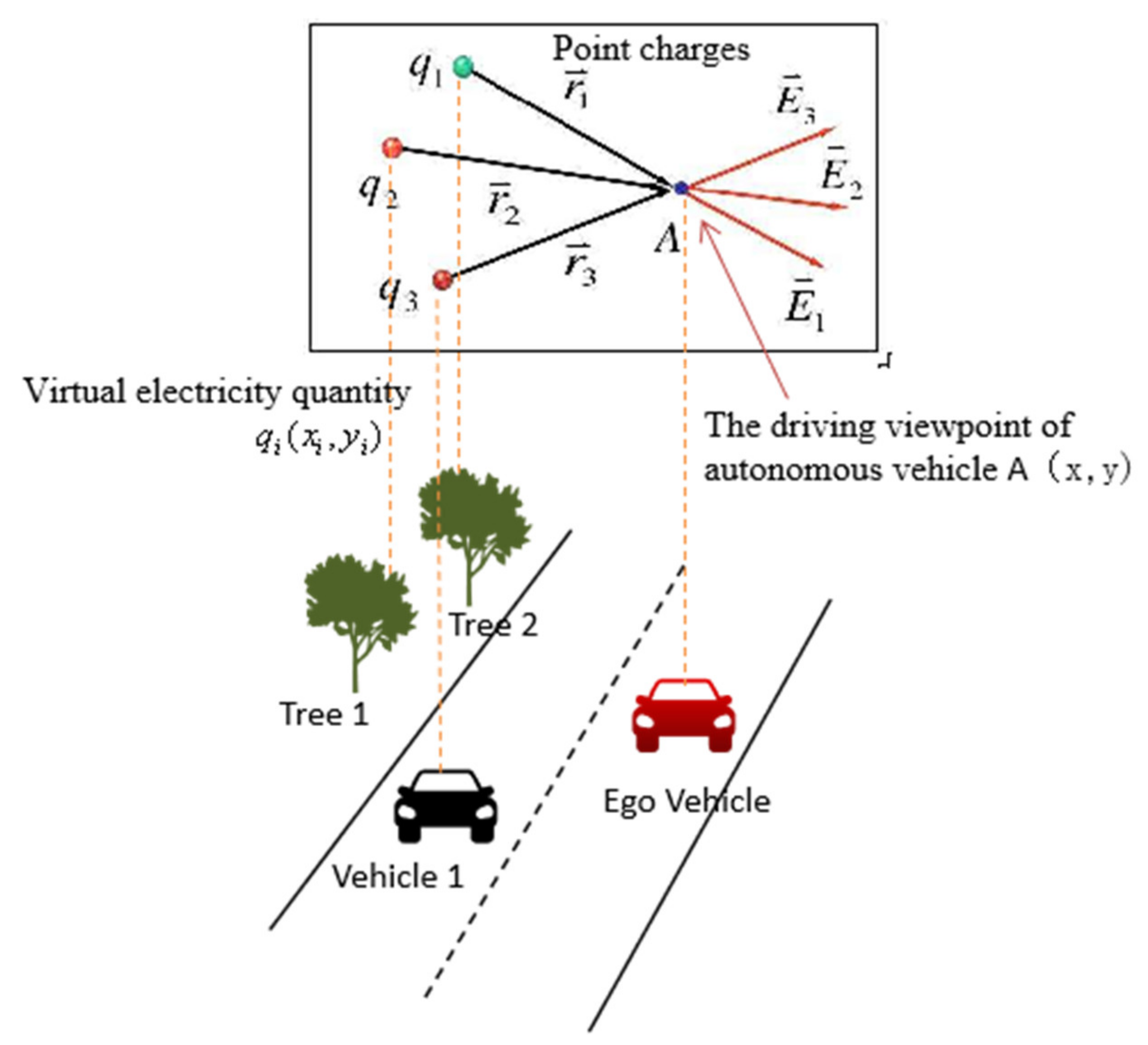

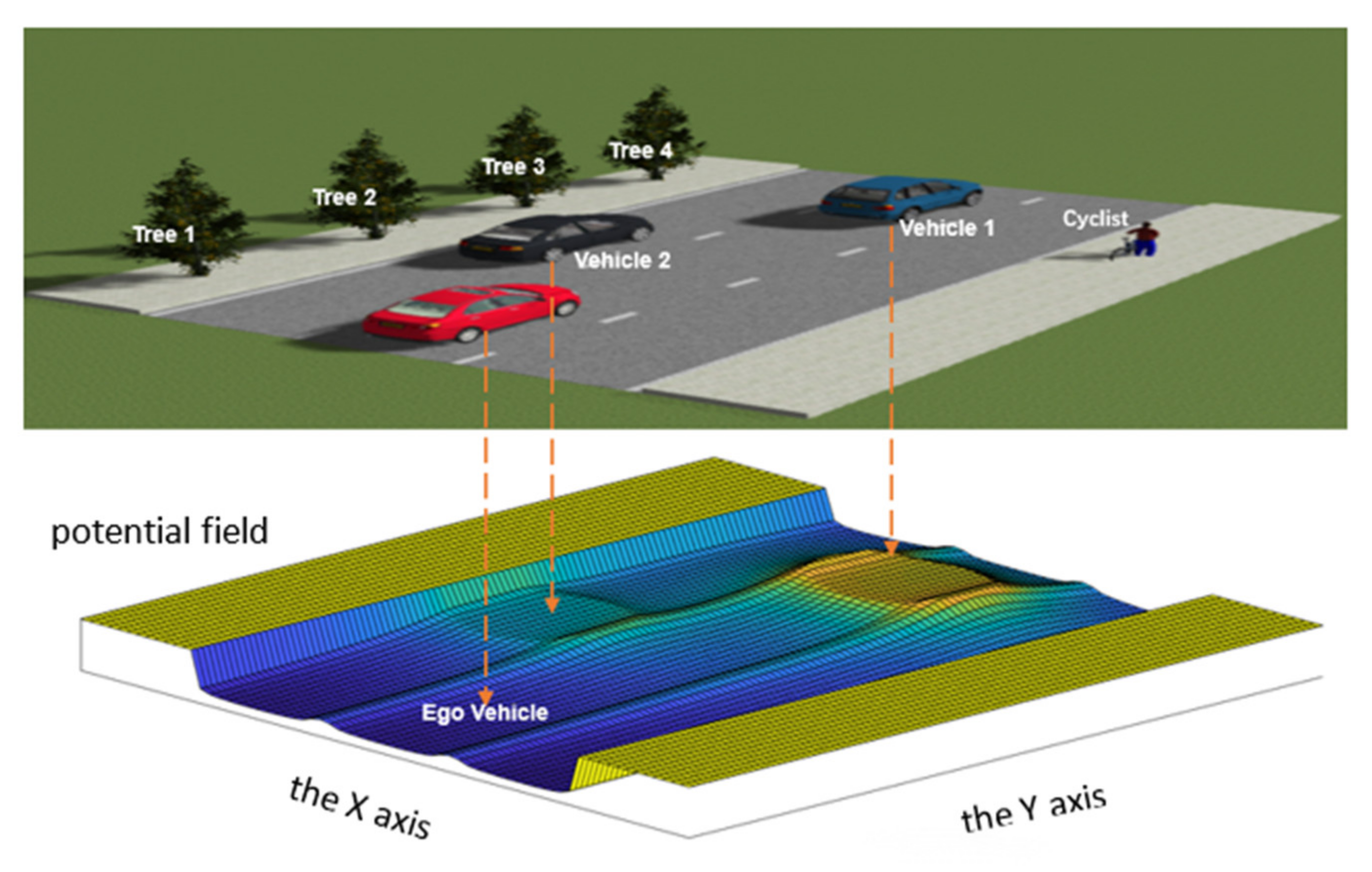
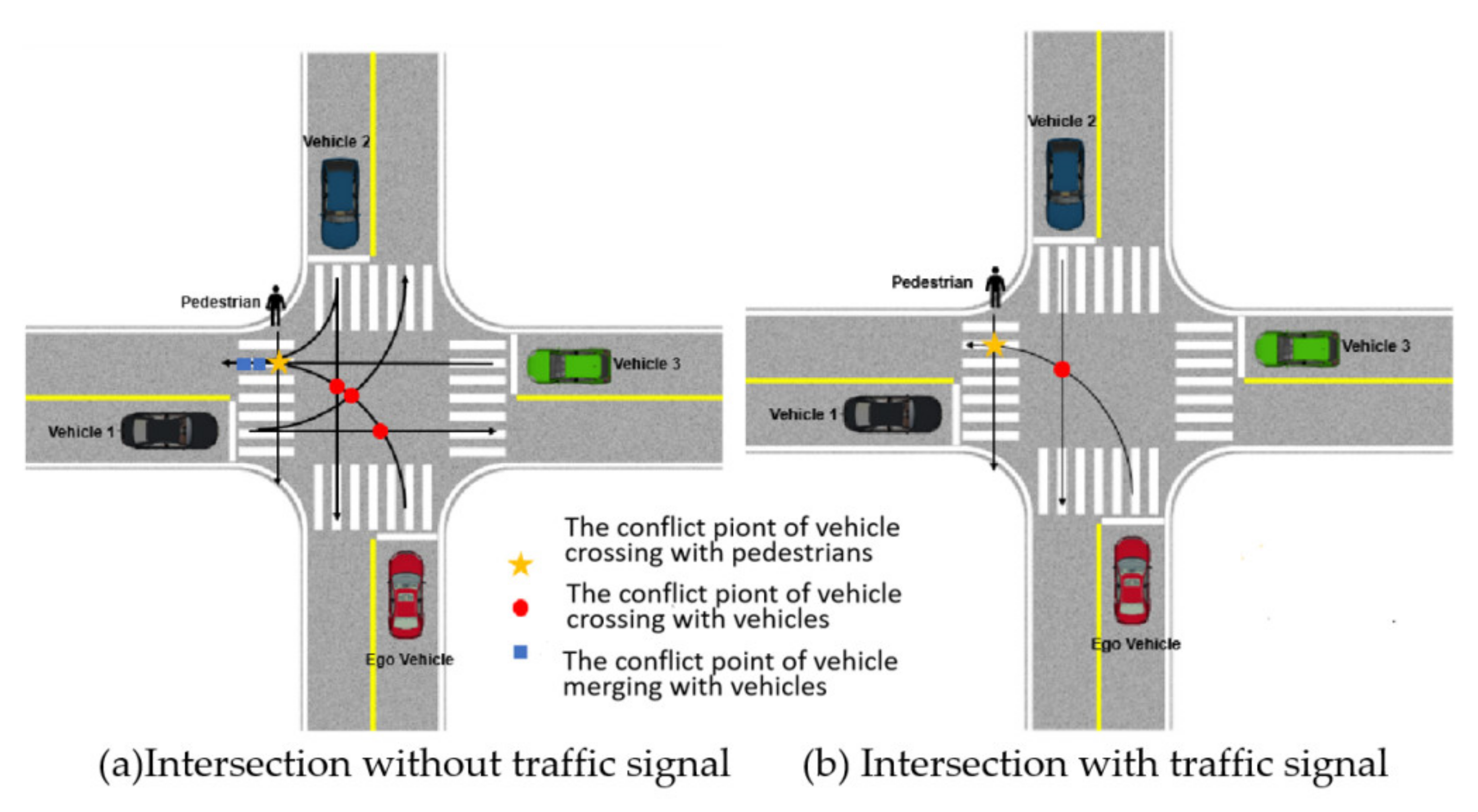
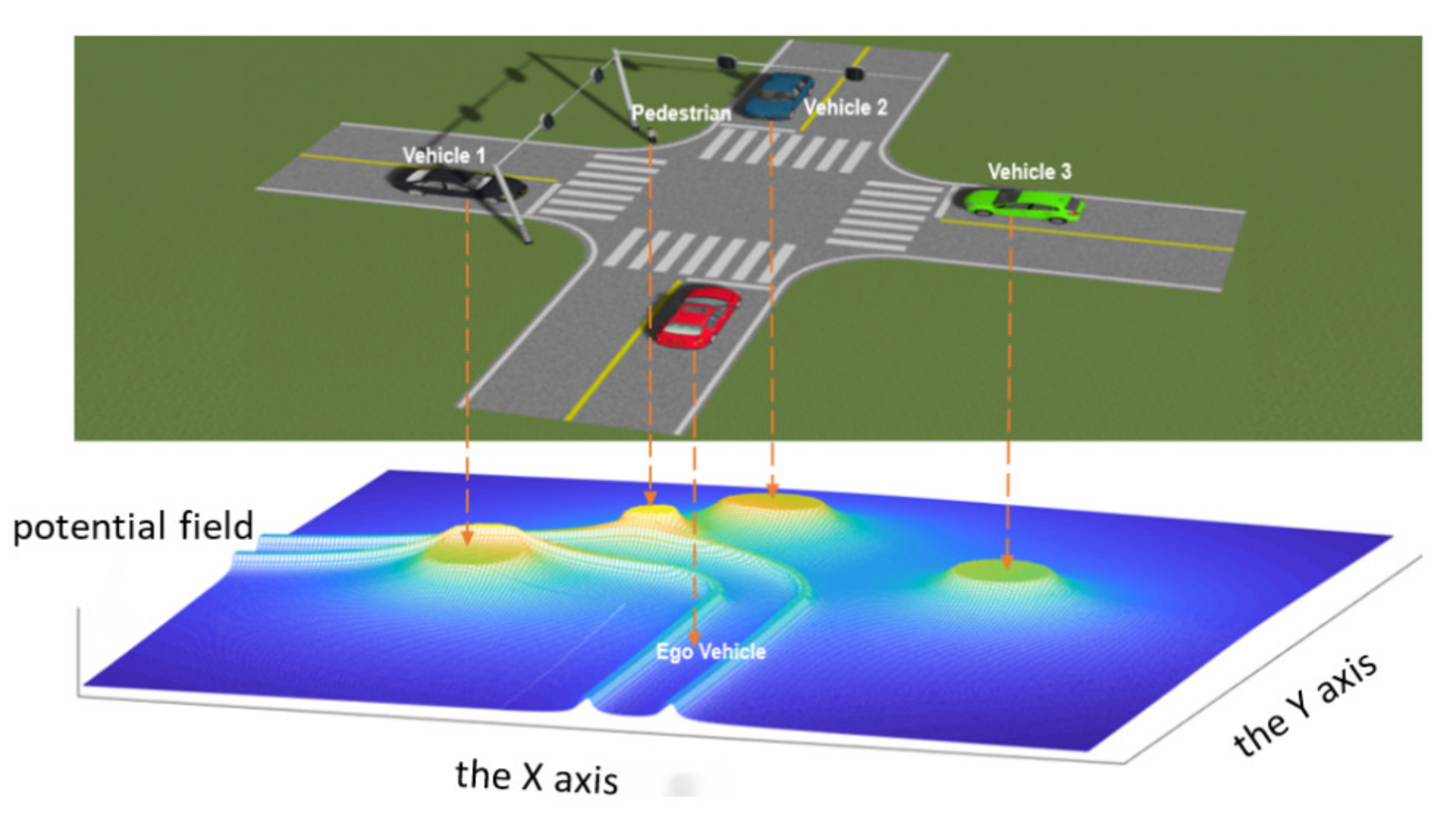

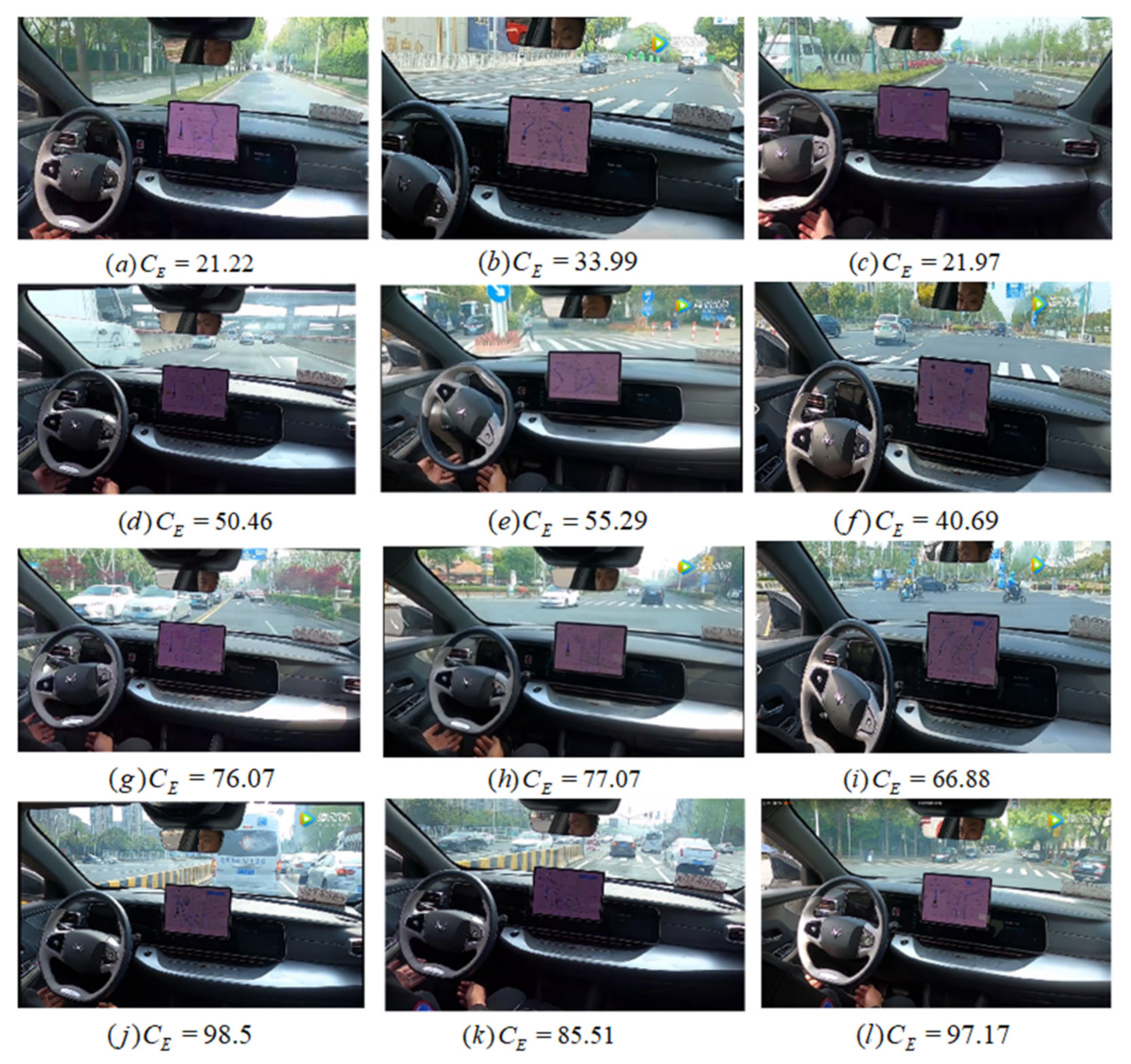

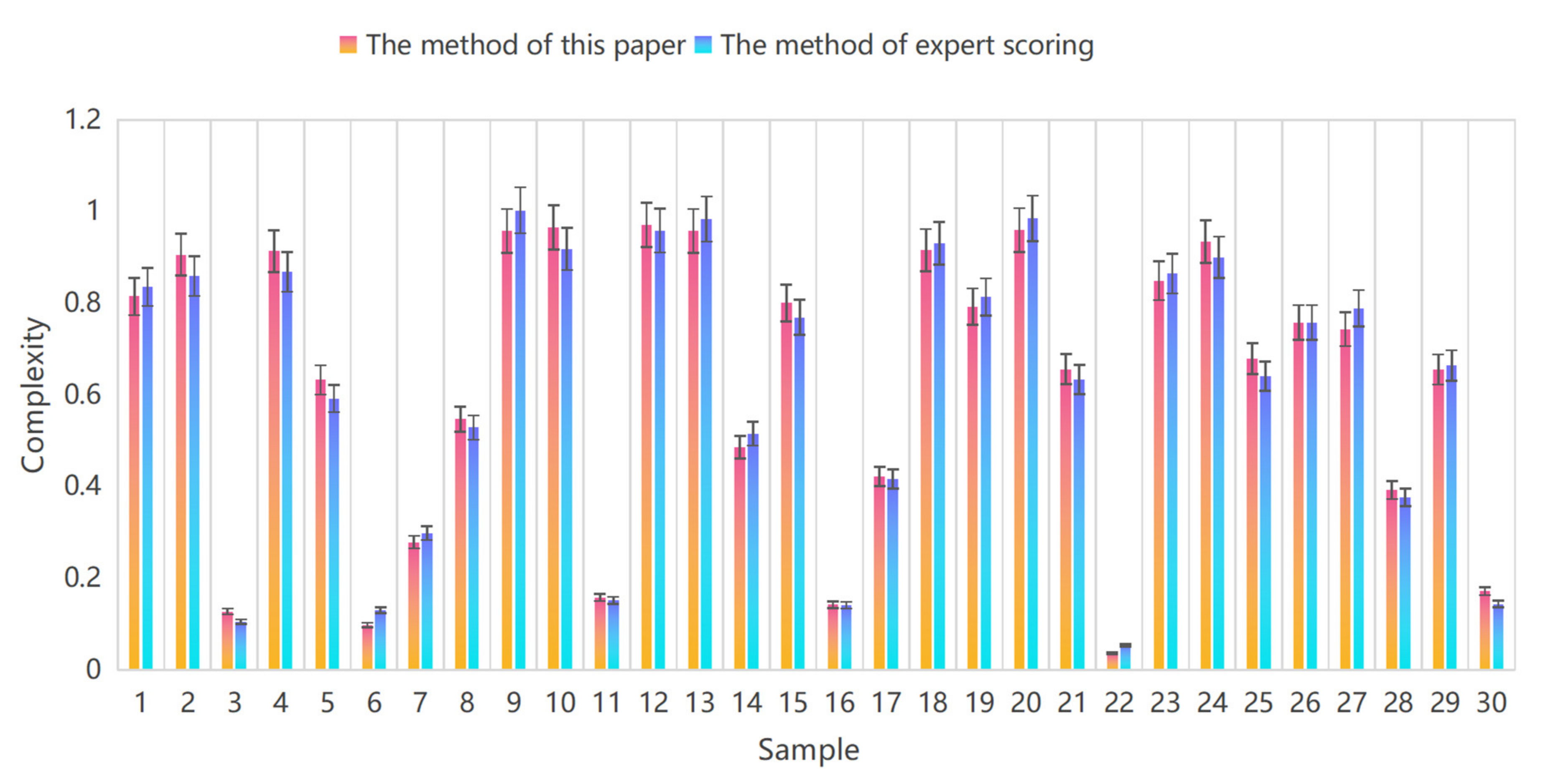
| Elements | A1 | A2 | A3 | A4 | A5 | A6 | A7 |
|---|---|---|---|---|---|---|---|
| Humans A1 | 1 | 2 | 3 | 5 | 6 | 4 | 9 |
| Motor Vehicles A2 | 1/2 | 1 | 2 | 4 | 5 | 3 | 8 |
| Animals A3 | 1/3 | 1/2 | 1 | 3 | 4 | 2 | 7 |
| Green Plants A4 | 1/5 | 1/4 | 1/3 | 1 | 2 | 1/2 | 2 |
| Ancillary Facilities A5 | 1/6 | 1/5 | 1/4 | 1/2 | 1 | 1/2 | 2 |
| Signs A6 | 1/4 | 1/3 | 1/2 | 2 | 2 | 1 | 3 |
| Marking Lines A7 | 1/9 | 1/8 | 1/7 | 1/2 | 1/2 | 1/3 | 1 |
| Element Classification | Humans | Motor Vehicles | Animals | Green Plants | Ancillary Facilities | Signs | Line Marking |
|---|---|---|---|---|---|---|---|
| Name | Pedestrian Cyclist Non-motorized vehicles | Car Bus Truck | Poultry Livestock Wildlife | Trees Shrubs Semi-shrubs | Telegraph Pole Isolation Strip Traffic Guardrail | Warning Signs Prohibition Signs Indicator Signs | White Lane Lines Yellow Lane Lines — |
| virtual electricity quantity |
| Order | Environment Element ID for Complexity Calculations | Category of Environmental Elements | Name of Environment Elements | Virtual Power Quantity | Distance/m | Angle/° |
|---|---|---|---|---|---|---|
| 1 | A40206 | General road guide sign | Cross intersection informed sign | 18 | 38 | 0 |
| 2 | A30102 | Indication sign | Sign of Turning left | 5 | 13 | 0 |
| 3 | B20102 | Prohibit marking line | Double-yellow solid line | 16 | 0.7 | −90 |
| 4 | B10106 | Indicate marking line | White dotted line at the roadway edge | 12 | 0.3 | 90 |
| 5 | C50304 | Green plants | Bush | 8 | 4.5 | 90 |
| 6 | D30300 | Vehicle | Vehicle1 | 22 | 35 | 0 |
| 7 | D30300 | Vehicle | Vehicle2 | 22 | 32 | 12 |
| 8 | D30300 | Vehicle | Vehicle3 | 22 | 4 | −29 |
| 9 | D30300 | Vehicle | Vehicle4 | 22 | 4.5 | −41 |
| 10 | D30300 | Vehicle | Vehicle5 | 22 | 8 | −20 |
| 11 | D30300 | Vehicle | Vehicle6 | 22 | 12 | −16 |
Publisher’s Note: MDPI stays neutral with regard to jurisdictional claims in published maps and institutional affiliations. |
© 2022 by the authors. Licensee MDPI, Basel, Switzerland. This article is an open access article distributed under the terms and conditions of the Creative Commons Attribution (CC BY) license (https://creativecommons.org/licenses/by/4.0/).
Share and Cite
Cheng, Y.; Liu, Z.; Gao, L.; Zhao, Y.; Gao, T. Traffic Risk Environment Impact Analysis and Complexity Assessment of Autonomous Vehicles Based on the Potential Field Method. Int. J. Environ. Res. Public Health 2022, 19, 10337. https://doi.org/10.3390/ijerph191610337
Cheng Y, Liu Z, Gao L, Zhao Y, Gao T. Traffic Risk Environment Impact Analysis and Complexity Assessment of Autonomous Vehicles Based on the Potential Field Method. International Journal of Environmental Research and Public Health. 2022; 19(16):10337. https://doi.org/10.3390/ijerph191610337
Chicago/Turabian StyleCheng, Ying, Zhen Liu, Li Gao, Yanan Zhao, and Tingting Gao. 2022. "Traffic Risk Environment Impact Analysis and Complexity Assessment of Autonomous Vehicles Based on the Potential Field Method" International Journal of Environmental Research and Public Health 19, no. 16: 10337. https://doi.org/10.3390/ijerph191610337
APA StyleCheng, Y., Liu, Z., Gao, L., Zhao, Y., & Gao, T. (2022). Traffic Risk Environment Impact Analysis and Complexity Assessment of Autonomous Vehicles Based on the Potential Field Method. International Journal of Environmental Research and Public Health, 19(16), 10337. https://doi.org/10.3390/ijerph191610337







